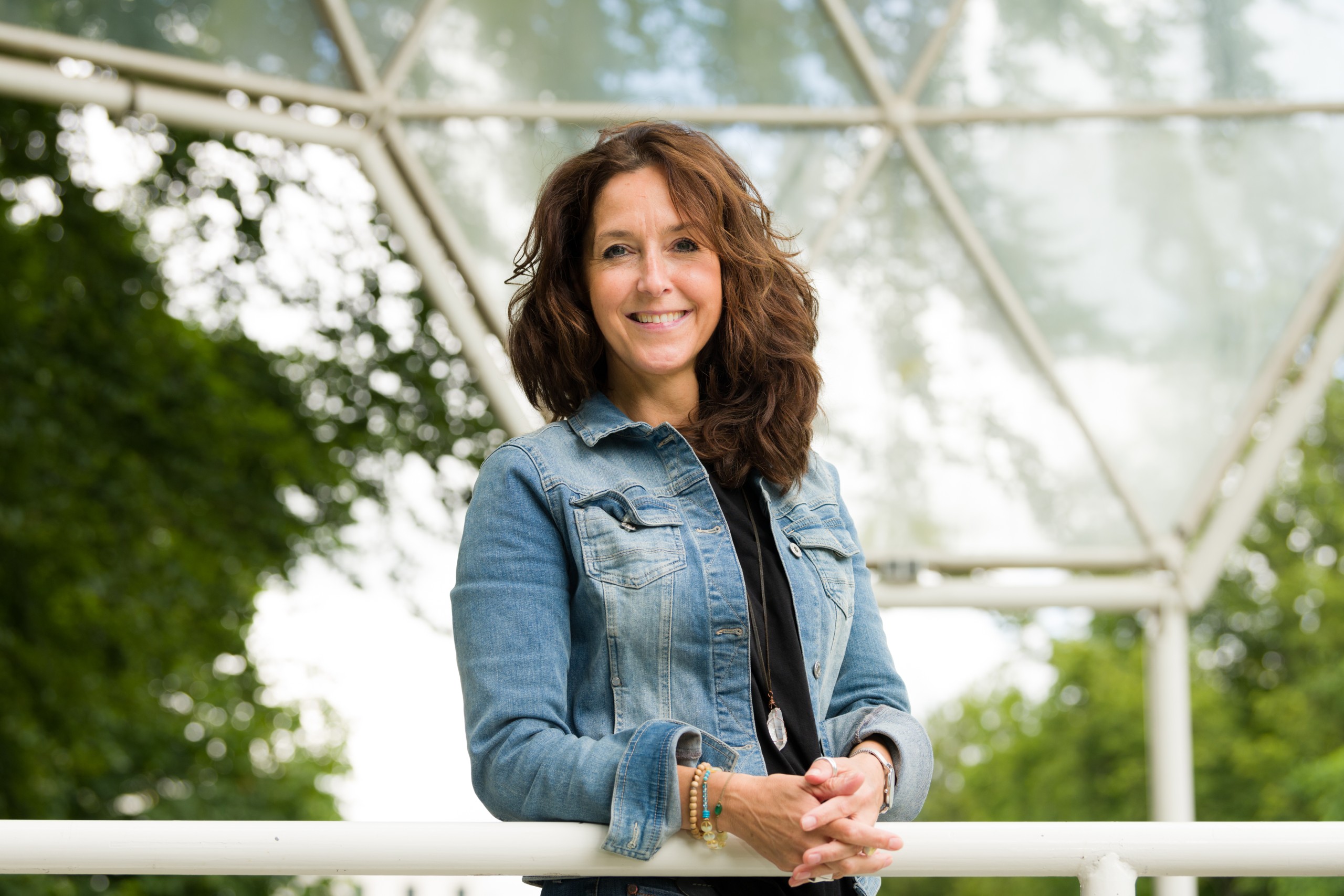By Bronwen Firth
Esther van der Sande is a somatic neuro-psychotherapist (MA), yoga and trauma therapist, TCTSY-facilitator, and a faculty member at the Centre for Trauma and Embodiment at JRI Boston and trainer & supervisor of the Certification Program of TCTSY. As a faculty member of the Yoga Therapy Institute, Esther teaches the ‘Trauma-Informed Yoga Therapy’ and ‘Applied Somatic Counselling Skills for Yoga Therapy’ modules, in which her experience, knowledge, and compassionate approach provide an invaluable framework for integrating trauma-informed principles into our Yoga Therapy training and practices.
What is the difference between trauma-sensitive and trauma-informed in the context of Yoga Therapy?
‘Trauma-informed’ refers to the building of an awareness and recognition of how common trauma is and how it affects our wellbeing, our families, and our communities. When there is a wider understanding of attachment issues and developmental and complex trauma, we can create a framework for working with the body, based on the understanding of self. In trauma-informed Yoga Therapy, we use a Biopsychosocial model, which provides a recovery-orientated outlook, focusing on the whole context of the client.
‘Trauma-sensitive’ refers more to what we, as Yoga Therapists, actually do with our clients during a Yoga Therapy session. Trauma-sensitive training provides us with a model to work with, however, this model will depend on which ’school’ you have trained with and requires additional specialized studies. Trauma-sensitive yoga requires additional, specialized training over and above the Yoga Therapy training.
Why is a trauma-informed approach so important in our work as Yoga Therapists?
If we work in a trauma-informed way with our clients, we create a positive relationship, based on acceptance and understanding, which promotes overall wellbeing in a way that can help our clients heal. We also avoid violating boundaries and reduce the possibility of doing harm. By working together with our clients, within a trusting and therapeutic environment, our clients will feel validated and connected to their therapist and to themselves. This creates fertile ground for the development of agency, self-confidence, safety, and an ability to make choices, thereby allowing our clients to assume some control over their lives. To sensitively facilitate integration and the reconnection of the body systems disrupted by trauma, a Yoga Therapist needs to be authentic, sincere, down-to-earth, and trauma-informed.
How does working with the body, as well as cognition, make Yoga Therapy such a powerful modality?
We now understand how trauma is held in the physical body, through the autonomic nervous system, and how movement therapy can support healing. The combination of cognitive therapy, which works from the head/top down, and Yoga Therapy, which works from the ground up, is the key to re-connection after trauma. Information from the muscles moves to the brain and the Yoga Therapist can create a conducive environment (physical and emotional), a new language for exploring emotions, and encourage clients to distinguish past from the present. This provides hope, builds strength, and facilitates empowerment. Clients do not always need to revisit their trauma in a therapeutic session, clients may choose to revisit their own traumatic experiences in their own time, when they feel ready to do so, from a place of safety and support.
It is so valuable to ask the question
“What happened to you?” rather than “What is wrong?”.
In Esther’s own words:
” my dream is to create a more trauma-informed world, where acceptance and understanding become the norm”

How does the oversimplification and the indiscriminate use of the word ‘trauma’, within society and the media, impact trauma work?
I am concerned that, because it has become a buzzword and a topic that sells so well, it is being misapplied and misunderstood. This lack of understanding of the complexity of trauma can mean that uninformed practices can be dismissive of people’s experiences and harmful, despite good intentions. Inadequate knowledge, failure to be inclusive, trustworthy, or collaborative can cause harm, re-trigger trauma, and negatively impact the establishment of a positive therapeutic relationship, engendering a lack of compassion and respect.
It can also create an assumption that everyone has trauma and we lose sight of the fact that it is an extremely complex issue, with degrees of trauma. On the other hand, in some instances, people may not be aware they have experienced trauma, so keeping trauma on our radar is important.
It is vital that people recognize that trauma is not limited to the individual – the whole community is, directly and indirectly, affected by trauma. Trauma does not operate in isolation and needs to be approached from a much broader and deeper perspective. Working with trauma in a superficial way undermines the very nature of trauma work, which requires awareness, honesty, safety, and understanding within the context of a shared authentic experience.
Can we explore the concepts of freedom versus structure within a trauma-informed practice?
People who have experienced trauma, have often had the power of choice taken away from them. Our nervous system loves choice in a safe, contained environment where predictability can promote feelings of safety and enable positive choices. However, too much structure can become oppressive when it becomes hierarchical and used for control or manipulation. Similarly, too much freedom can cause feelings of insecurity and vulnerability. The opportunity to progress at their own pace, however, is a positive way in which freedom of choice can be a support to healing. People can take their time to gently free themselves from their defense strategies, when they are ready, and have the time to build emotional resilience and to be more resourced. In much the same way as the balance is intrinsic to yoga, a balance between structure and freedom, form the basis of an effective trauma-informed Yoga Therapy practice.
Why do Yoga Therapists need to take the time to practice self-care?
Yoga Therapists are often, naturally tuned into what others need – that is why they are drawn to this type of work. If they are not grounded and do not practice self-care, they can easily accumulate other people’s trauma. In order to be able to hold a safe space for clients, a therapist must know their own history and tend to their own emotional wellbeing. The intrinsic value of the therapeutic relationship lies within the ‘shared experience’. Whilst working with a client, you may notice experiences within your own body or pick up and embody emotions being experienced by a client. Practicing self-care by being aware of these feelings and finding a way to release them, is vital in order to sustain the supportive care clients need and for the therapist to sustain their own equilibrium and wellbeing.
Working compassionately as a Yoga Therapist, in a trauma-informed way, requires mutual respect, dignity, and an acknowledgment that clients ‘know’ themselves – they are not broken and we do not need to fix them. We simply guide them towards working it out for themselves, within a kind, caring, and safe setting.
Knowing the enormous benefits that result from focusing inwards and caring for yourself, Esther van der Sande created the School of Self-Care, (www.theschoolofselfcare.org) with the aim of providing individuals and professionals with the knowledge, tools, and guidance to take better care of themselves.
To enroll for the ‘Trauma-informed Yoga Therapy with Esther van der Sande’ or ‘The Somatic Counselling Skills for Yoga Therapists’ modules, please email kaz@theyogatherapyinstitute.org or visit our website www.theyogatherapyinstitute.org






Leave A Comment